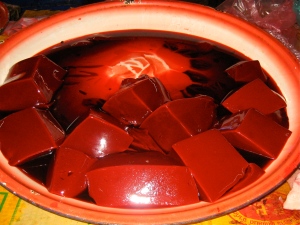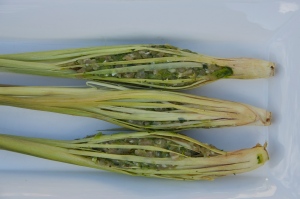Stuffed lemongrass. It sounds like trying to push a square through a triangle-shaped hole, doesn’t it? That’s what I thought when I first saw the dish on a menu in Laos.
I could imagine the subtle citrus flavour permeating the stuffed ingredients, which tend to be a mixture of minced chicken or pork, chopped spring onions or shallots, and aromatics such as coriander and kaffir lime leaves – depending on who’s manning the mortar and pestle. But I couldn’t picture how you would tunnel out the interior of a stalk of lemongrass and stuff it. My curiosity was piqued.
During our culinary trail around Laos, i noticed several cooking classes were being touted around the heritage-listed town of Luang Prabang, but when I saw ua si khai (stuffed lemongrass) on the itinerary at Tamarind restaurant’s cooking school, I was sold.
I will share Tamarind’s recipe, but first a little about the cooking class.
The class was hosted by Tamarind owners, Australian expat Caroline Gaylard and her Lao partner and the restaurant’s chef Joy Ngeuamboupha.
First we set off to the local market where Caroline surprised me with the extent of her knowledge of local ingredients.
Nothing is wasted in this peasant economy: rattan and tree barks, river weed, bitter herbs, dried buffalo skin, dirty-green bile, and congealed blood – deep crimson in hue and the consistency of firm tofu – all have a place in the country’s gastronomy.
Bile is used to tenderise tough meat – such as water buffalo, the flesh and skin of which is added to many dishes. River weed is topped with slithers of tomatoes and garlic and dried in the sun – the perfect beer snack.
Rattan is scorched over a flame, stripped of its thorny outer bark, and the softened inner flesh is pounded – sometimes with chilli paste and ginger – or added to dishes. Pieces of the uncooked core are added to orlarm (Laos stew), which lends the dish a slightly bitter flavour.
The female market traders all sported bright red aprons that are doled out by MSG distributors, which attests to the pervasive use of monosodium glutamate as a taste enhancer in Laos cooking.
A single stall of river fish, where once there were many, amongst a sea of counters selling ocean catch hinted at problems of over-fishing and the Chinese dams along the Mekong.
After our market tour, the baton was passed to Joy who took us to Tamarind’s property about 10 minutes out-of-town, where, in an open-sided wooden structure next to a beautiful pink lotus pond, we were introduced to the intricacies of Laos cooking.
A huge basket of ingredients was laid out before us: lemongrass, Laos basil, small and fiery chillies, cloud ear mushrooms, coriander, dill, galangal, mint, snake beans, and eggplants.
First, Joy demonstrated how to make sticky rice – a Laos staple which is eaten in bite-sized balls with the fingers alongside small morsels of food or dipped into spicy sauces. The rice is rinsed, soaked for at least several hours, and rinsed again. Then it is cooked for about 30 minutes in a bamboo steamer, or houad, over water heated in a maw nung (maw meaning pot, and nung meaning steam) on top of a traditional Lao charcoal burning stove or tao-lo.
Soon the smell of burning coals and the rhythmic sound of pounding permeated the air as we charred eggplant over open flames and pummelled it with chilli, salt, garlic, coriander and a pungent fermented fish sauce known locally as padek – or bottled fish sauce for the less adventurous – to make jeow mak keua (eggplant dip). Then we tackled stuffed lemongrass.
The stems are not hollowed out, as you might imagine. Instead, using a small sharp knife, and starting about 1cm from the base of the lemongrass stem we made cuts lengthwise through the stalk about 4-5cm in length – without letting the cuts reach either the base or the cut top end of the stalk.
Rotating the lemongrass we repeated the cuts at small intervals, until the outer stalk was serrated – basket-like – creating a central hole for the filling.
In the Traditional Recipes of Laos – a translation of the recipes of the late Phia Sing, Master of Ceremonies and Chef at the Royal Palace – readers are told to use a needle rather than a sharp knife to open out the strands of each stalk.
Joy’s recipe is for 12 stalks of lemongrass. The filling consists:
- 5 cloves of garlic
- 4-6 spring onions
- 1/2 – 3/4 cup of fresh coriander
- 1 kaffir lime leaf
- teaspoon of salt
- 200g minced chicken
All of these ingredients except the minced chicken are pounded in a mortar and pestle, then the minced chicken is added and mixed well.
The next step is to push a spoonful of the mixture into the central core of each stalk, then shape and smooth it out with your hands.
Dip the stuffed lemongrass in beaten egg (you’ll need two eggs) and fry them in a wok (stalks protruding and resting on the side so they can be easily withdrawn) until the meat is browned and cooked.
It’s like an inside out version of Vietnamese nem lui Hue, or Hue lemongrass skewers, where minced meat and other ingredients are moulded onto the outside of lemongrass stalks and grilled.
These stuffed stalks are herbaceous, pocket-rockets of flavour. Be warned: they’re addictive.
Also on the menu was mok pa (steamed fish in banana leaves) which consisted of cubed white fish, mixed with fish sauce and a paste made by pounding rice powder, shallots, garlic, chilli, lime leaves and salt, to which dill, basil and spring onions were added and further pounded.
The mixture was packed together in parcels made from banana leaves – which we decorated with twists of leaf and chillies so that our individual packages could be distinguished after being cooked in the communal steamer.
Finally we made orlarm (Laos stew) by simmering pork or buffalo, chillies, lemongrass, basil, coriander, dill, spring onions, long beans, black cloud ear mushrooms, chilli wood (which can be substituted with peppercorns), and pea eggplants in a pot of water.
A ball of sticky rice, roasted over charcoal and pounded into a powder was used as a thickening agent. The chilli wood left a lingering aftertaste which was slightly numbing on the tongue, and the water buffalo that i opted to use instead of pork was as tough as old boots. It’s not a dish i would try to replicate at home.
The class was extremely hands-on. Given few precise measurements we were encouraged to cook by touch and taste and learned the concept of a “Lao pinch” and “Lao spicy” – both far greater than the Aussie alternative.
It was a fascinating introduction to the many tastes and distinguishing features of Laos cuisine: the spiced, smokiness of jaew mak keua, the earthy bitterness of orlarm, and the subtle fragrances of myriad herbs and leaves.
So next time you fancy stuffing something for dinner, forget the capsicum, tomato, or eggplant. Grab yourself a stalk, or two, of lemongrass.











I miss Luangprabang… miss the people.. miss the foods..
I saw Chef Joy on a travel channel sometime last year…
LikeLike
I agree, it’s a magical place…wish i was back there right this minute. Chef Joy is great fun – i’d highly recommend his class to anyone who is in town. I caught him on the travel channel, too.
LikeLike
i had the stuffed lemongrass in Luang Prabang at the new tamarind location recently, absolutely outstanding! And the friendly staff gave me the recipe too! Too bad its so hard to find kaffir lime leaves in brisbane!
LikeLike
The stuffed lemongrass was a winner as far as we concerned. Good luck finding kaffir lime leaves. When you do come across them buy several bags and freeze what you don’t use!!
LikeLike
That looks incredible mouth watering! I never in my life would have thought to stuff lemongrass! Incredible!
LikeLike
It’s both an amazing concept & flavoursome dish.
Thanks for reminding me about it. Now I know what to do with the huge lemongrass bush in the garden!
LikeLike
Truly I am looking at my lemon grass differently now. I have a Huge Huge bunch that I have been meaning to do something with! Much Aloha! Emily
LikeLike
The fatter the lemongrass the better, for this recipe. It’s hands down the best – but also the fiddliest – way to cook these little gems! Good luck & let us know how you go.
LikeLike